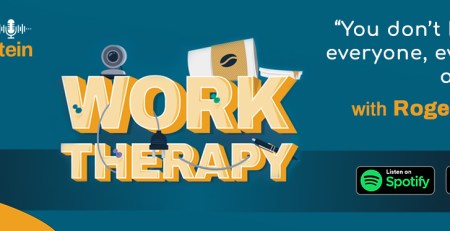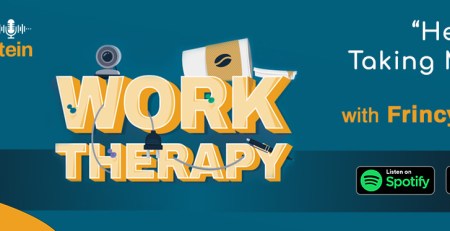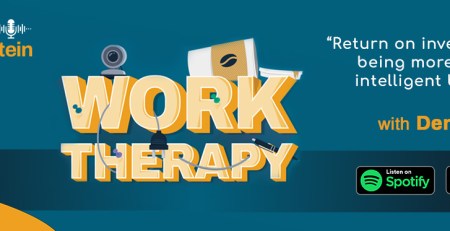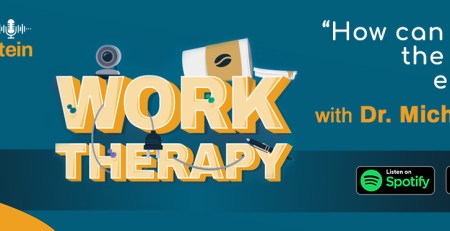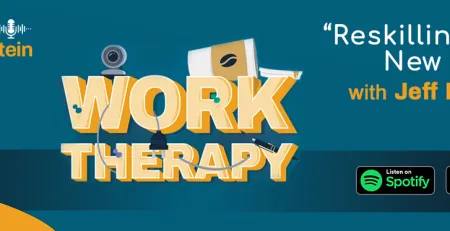Work Therapy: Thriving through constant change
In this week’s episode of Work Therapy with Dr. Steven Stein, we chat with Dr. Paul Bartone, a retired U.S. Army colonel, Visiting Research Fellow at the Institute for National Strategic Studies at the National Defense University, and Adjunct Faculty in Psychiatry at Uniformed Services University of the Health Sciences.
Dr. Bartone shares his insights into how to strengthen your ability to adapt in the face of change by cultivating a hardiness mindset.
DR. STEIN: Does this sound like a familiar story? A lot of people struggle with adjusting to new norms, policies, processes, and what feels like a constantly changing workplace, especially lately. And when you aren’t consulted or involved in the decision-making process, a job full of shifting priorities and never-ending deadlines can feel like whiplash, but it doesn’t have to feel that way.
DR. STEIN: I’m Dr. Steven Stein. I’m a clinical psychologist and founder of MHS, a leading developer of innovative scientific assessments in the talent development space and beyond. I’m here to tell you that work sucks sometimes, it does. I can admit it, but it doesn’t have to. In work therapy, we speak with experts from diverse backgrounds helping us wade through some of the most common issues people have on the job. We learn how to go beyond just surviving at work and learn how to start thriving because if work sucks, how can we fix it?
DR. STEIN: On this episode, Thriving Through Constant Change, I’m really excited to be speaking with my friend and colleague, Dr. Paul Bartone. Paul and I have both put a lot of work into researching how to manage the stress that comes along with change in the workplace. We even wrote a book about it. Paul is a retired US Army colonel, visiting research fellow at the Institute for National Strategic Studies at the National Defense University. He’s also an adjunct faculty in psychiatry at Uniformed Services University of the Health Sciences. He’s an expert in applying psychological, social, cultural and biological perspectives to the understanding of human behavior. Interestingly, Paul started his work in the space of hardiness and resilience after working summers as a bus driver in Chicago. Today we’ll be talking about how to strengthen your ability to adapt in the face of change by cultivating a hardiness mindset. What does it mean to have a hardiness mindset? I’ll let Paul explain.
DR. STEIN: Paul, thanks for doing this. I appreciate you coming on.
PAUL: Happy to do it, Steve, and it’s good to see you again.
DR. STEIN: You too. So, full disclosure here, Paul and I wrote a book together called Hardiness, so we actually know each other pretty well. But even though we’ve worked together, and we know each other, I’m still fascinated by your career history and basically how it influenced your work. Maybe you can tell us a bit about that.
PAUL: Well, sure. My career history is a long story, but as you know, most of my career has been with the U.S. Army. It’s an interesting story about how I landed in the army. I did my graduate work at University of Chicago, and there I ended up doing, for my dissertation research, a study looking at stress and health in bus drivers, Chicago bus drivers, which was something that I just kind of fell into by accident. Once I completed that, I was just on the job market looking for jobs. And the army happened to be looking for research psychologists at the time. So, I went ahead and interviewed, and I was given the job. And what I didn’t realize at the time was that I would’ve to put the army uniform on. This was like 1985, and there was still a lot of the post-Vietnam anti-military sentiment around, especially in academia.
PAUL: It seemed like a good adventure to me, but I really didn’t want to end up in academia, writing papers that didn’t matter, didn’t affect anyone’s lives. So, I thought in the army I could do work that might make a difference in people’s lives. And so, I did. I ended up at Walter Reed. That was my first assignment. I was able to continue to work on stress and health and illness and hardiness, which was a big part of my interest, stress resilience, if you will. And then, I had a couple of other great assignments, including commander of a lab in Heidelberg, Germany, Behavioral Sciences Lab. And from there to West Point.
DR. STEIN: We think of the army often as kind of a rigid type of a place where you follow the rules. And the topic that we’re covering today is around change. So, how does your work at West Point fit in with that?
PAUL: The West Point people were looking for someone who could not only teach, but also do research in the Department of Behavioral Sciences and Leadership. So, I took over that longitudinal research study, which was mainly looking at things like a number of different attitudes and mainly cognitive or mental intellectual predictors of leader performance in the cadet environment. So, one thing I was able to bring to that project was my interest in personality variables that may influence a range of behaviors, including behaviors as leaders, I was able to incorporate my hardiness instrument measure into the existing tools that they were using in the project to try to get a handle or an understanding on what are the ingredients, what are the factors that influence effective leadership and developing leaders in young people who really have no leadership experience.
DR. STEIN: What were some interesting findings that came out of this study, Paul?
PAUL: So, that led to a number of findings, including we learned that this thing called hardiness, which I know you’re very familiar with, Steve, was a very strong predictor of a number of things important in the cadet world. One was retention. So, cadets who were higher in hardiness actually stuck it through and ended up graduating after four years. Where at the time, and I believe it’s still true today, there’s a very high attrition rate. West Point is a very challenging, very difficult, very stressful environment for these 18, 19-year-olds coming in.
DR. STEIN: So, it sounds like hardiness was a strong predictor of success and retention?
PAUL: Yeah, that’s right. We had a number of indicators of performance including supervisor ratings, external ratings of leader behaviors and performance from multiple rating sources. And it was also a quite strong predictor of health in terms of symptoms and injuries and major illnesses as well. Another interesting finding that came up, I believe it was 1976 when they admitted their first class of women. What we found was that hardiness levels were actually higher in the female cadets than in the male cadets. And furthermore, that hardiness in women was actually a stronger predictor of certain things like military grades and military performance. So, the female cadets, although they’re a minority and they’re actually experiencing, in many ways, a great deal more stress than the males are because of their minority status. And along with that, there’s always been some level of harassment and hostility toward the female cadets. So, they’ve always had to deal with that anti-feminine bias, but the cadets were higher in hardiness, and it made an important difference for them in terms of adaptation and performance in that very difficult environment.
DR. STEIN: Paul, what truly makes a person hardy? And outside of the army, how does this translate into people’s everyday lives and what they’re dealing with?
PAUL: I very much believe that the hardiness mindset is very important for adaptation and survival, mental health survival in difficult circumstances. Hardiness is made up of three primary elements or facets, if you will. And the first is commitment, which is really all about having a good strong sense of purpose and meaning in life, having passionate activities, endeavors that you’re passionate about. But more than that, just having a passion for life in general. So, commitment in a broad sense. Control, which is just the belief that your actions and your decisions make a difference in terms of outcomes, have an influence on outcomes. You’re in control of your own destiny if you will. And then the third hardiness component being a sense of challenge, which is really all about a kind of a receptivity, a willingness to… It’s an attitude toward change. The people high in challenge recognize that change is kind of a necessary part of life.
DR. STEIN: So, what I think that you’re saying here, Paul, is that people who are high in hardiness know they can make an impact in their own lives and that they have the resilience to look forward and take on challenges.
PAUL: We can’t predict the future. The future’s uncertain and it always will be. But people with a high sense of hardiness challenge recognize that, understand that, almost, in many ways, look forward to it. They recognize that life is full of surprises, but the surprises can be fun. And even the bad surprises when things go wrong, provide opportunities to learn and develop and grow to learn about yourself, to learn about other people, to learn about how you act and react in certain situations.
DR. STEIN: So, two main things you’re referring to is that hardiness mindset, which it’s a mental thing, the way you think about things. And the second is this social support that you mentioned. So, what does a successful hardiness mindset look like?
PAUL: If you’re high in hardiness, you want to control things, what do you do? One of the things we see that the cadets who are high in hardiness are able to do is find areas of life that they can exert some control over. It might be their study habits; it might be their choice of what physical sports activities to engage in. There are some ways that control can be maintained even within environments that where things are kind of out of control. And I think that that’s a lesson that generalizes to a lot of environments outside of West Point, including organizations that are experiencing rapid change.
DR. STEIN: Yeah. Well, let’s move into that. Let’s talk about some organizations. And we see a lot of change going on now, especially post-COVID with changes in the workplace. So, if you were, I don’t know, helping coaches who deal with people struggling with change, what would you tell them to focus on? How would you tell to help the people that are having a difficult time?
PAUL: The COVID pandemic, which we’ve all experienced for the last, I don’t know, three years now, is a good example of how things can change rapidly in the external environment. But it was a very disruptive, very painful period of time for many people, more for some than others. But everything about it, all the uncertainty, not knowing what to do, how far this was going to go. Now, as we look back at it, we can see that there were a lot of good things to come out of it. COVID kind of forced us to push forward in terms of remote connectivity, being able to hold virtual meetings, to get things done in organizations. Distance learning, many universities had to really scramble to figure out how to transform and offer courses in a virtual environment. And that was a difficult process, but it did push us ahead.
PAUL: Relationships for many people got stronger, and many people came to value their relationships, their family relationships, their friendships to a greater extent than they had before. So, we can look back and see that even through all this chaos, there were benefits. And that’s generally true through chaotic times. Now, if you can take that perspective that, yeah, there are benefits, there are good things to be found even in painful, disruptive, chaotic events, even in disasters, opportunities to learn and grow in terms of organizations and systems and organizations, but also in terms of personal values and relationships. Then it can strengthen those mental attitudes that then people can carry with them and that can help to kind of fore arm them to better deal with and adapt to future and even present chaotic situations.
DR. STEIN: So, are you saying that chaos is good, Paul?
PAUL: Change is good, yes, but we’re human too. We need stability. Everyone needs some stability and regularity in their lives. We all do. So, if our lives are constant disruption and change and unpredictability, well, that’s not good either. So, one of the things that I would tell individuals as well as leaders is that in leading through chaos and in dealing through change and disruptive times, it’s important to find some activities, maintain certain activities that provide you with some stability and predictability that may be whatever your routines are. It’s important to maintain those as much as you can. It might be you go for a run in the morning, or you stop and spend some time meditating at lunchtime, whatever it is. Not one size fits all, but it’s important to maintain, to some degree, the routines that provide some predictability in your life. So, it’s not directly related to the hardiness mindset, but it is indirectly in terms of the control issue and being able to maintain some control in the midst of chaos and rapidly changing external environments.
DR. STEIN: So, Paul, one of the questions I want to ask you is, why do people hate change so much? Why does change suck so much for some people?
PAUL: Well, in a lot of ways, change sucks for all of us, I guess. I mentioned we’re all human and we tend to prefer stability and predictability in our environments. In fact, in some respect, we’re always searching for predictability. We’re always trying to predict the future. We’re learning animals. And most of what we’re learning is in one way or another, related to a desire to be able to predict the future and avoid surprises, right? Change is disruptive for most of us, even the high hardy people, even those who can deal pretty well with change. But one of the reasons why it sucks so much, and it sucks more for some than others, is that it goes back to perceptions and what you recognize in yourself.
PAUL: People who are high in hardiness and have a history actually of being able to deal effectively with surprises in their environment. So, they have a history of success that they can reflect upon and draw upon. And they also recognize that it’s that very history of being confronted with a surprise and then dealing effectively. So, they have the resources, the wherewithal, the knowledge, the skills to cope effectively with that surprise. They know that. So, that gives them the sense of competency that, “I can deal with this.” Not everyone has that. So, sort of paradoxically, the way that develops is by experiencing change and disruption, but also dealing effectively with it, not being overwhelmed by it.
PAUL: And that’s why I also say, and this is another factor, and I’ll stop here, is that one of the things that leaders can do in organizations to help people deal effectively with change and chaos is use a crawl, walk, run approach. That is present your workers with challenges that are geared toward their available competencies, what they’re able to do, or maybe a little bit above what their competence to do. So, they’re forced to come out of their comfort zone a bit, but it’s not so great a shift that it’s overwhelming and just anxiety-producing. So, to the extent that leaders can structure performance challenges in a way that is gradual, then that’s a way of helping people to grow and develop and be better equipped to deal with change and surprise and disruption.
DR. STEIN: So, if we could kind of summarize some of that, what would you tell leaders, supervisors, managers, what would you tell them or advise them in terms of dealing with this change? What can they do?
PAUL: One is it’s a very obvious one, very simple and easy to do, and that is provide information. Let people know what’s going on, whether you’re a military leader or a CEO or a manager, to the extent that you have information about what’s happening, find ways to deliver that, to communicate that information to the troops. Information, whatever it is, that extends in another way. And that is a lot of times, you mentioned earlier, Steven, that the military is a very structured, hierarchical, kind of a controlled environment, and it is. But even so, when there’s a mission, when we have to go off and do something, some leaders will stop and find ways to talk to the troops. And you see this in private organizations as well. And let them know not only what we’re doing, what the timetable is, where we’re going and when, to the extent that operational and security considerations will permit that, right?
PAUL: But also, why we’re doing it, what’s behind it, what’s the purpose? Another thing that leaders can do, and it’s very simple, very easy to do, give recognition. Recognize people for their positive performances and accomplishments, whether it’s official awards, a pay raise, a bonus when deserved. Just as important a pat on the back, an attaboy, as we say in the military. Tell them you did a good job. And on that score, actually, Sal Maddi, the father of hardiness, had an interesting thing to say. This is not an original idea on my part. But he was right when he said that “In some respects, group awards, an award for team performance, when you can manage that in an organizational environment is even more valuable and probably safer and more effective than individual awards.”
PAUL: That is another point. Leaders need to be careful to be fair, to be equitable. And you can see how that will play out in the granting of awards and praise. So, leaders have to be careful with that and provide meaningful work, communicate to the soldiers that they’re doing meaningful work, but that’s hard to do if what they’re doing is wasting time.
DR. STEIN: So, you mentioned leaders have to give information, put people in the loop, make them feel part of what’s going on. You mentioned they have to reward people. It’s important to recognize their accomplishments and to be fair. People don’t want to see leaders as being unfair or favoring certain people over others. And this area, which I was actually going to ask you about, gets to control. So, we have to give people a sense of control in the way you seem to be recommending here is give them some tasks that are not too difficult, not too challenging, but just enough to have them reach a little bit and increase that, so that they feel a sense of accomplishment, getting things done and doing the challenge. So, you’ve managed to pretty well cover all the areas of hardiness in there. Leaders have to develop all these different skills.
PAUL: Yeah, that’s right. And it’s not always easy, and leaders do not always have the luxury of controlling what the challenges are and in what sequence they are presented. But especially in training environment, it is possible. And a lot of time in the military, and I would hazard to say a lot of time in the corporate world as well, is spent in training, in developing activities. And at least in those contexts, leaders, program planners, indeed, can sequence the challenges in ways that are not necessarily guaranteed, but more likely to develop that sense of competency and, “I can do this,” rather than a sense of just failure, “I’ll never be able to do this.”
DR. STEIN: Right. So, it’s about setting achievable standards then?
PAUL: Along with that, Steven, is always emphasizing leader utterances, what we say about these things, how we describe them, has a big impact. So, when there is a failure, when somebody fails at something, do leaders castigate them for that, sort of beat them up for it, criticize them? Or do they stop and say, “Okay, sit down. Let’s look at this. What did you do right? What did you do wrong?” Kind of analyze it and think about what you might want to do differently to meet such challenges in the future. So, how these things are discussed and talked about is also important.
DR. STEIN: So, if you’re not a leader, average person at work, undergoing change from whatever’s happening around them, how can they handle change better? What can they do in their own personal lives to make things better?
PAUL: I go back to the hardiness model. Commitment is about meaningfulness and purpose in life. If you’re not finding it at work, find it somewhere else. Find it at home, find it in your relationships, find it in your hobbies, your activities. Do things that you find enjoyable and important and meaningful that you can be passionate about. Control. If things seem to be out of your control, the world is spinning around you, we can always find areas of life where you can reassert control. If nothing else, it’s how you think about things, how you perceive and how you think about yourself. Am I a failure or am I just someone who needs to work harder to develop in this area? And challenge, try to remember that change, although it can be painful, it’s always an opportunity to learn. You can always get something good out of it if you look. Commitment, control, and challenge. And there are things that people can do to help themselves in those areas.
DR. STEIN: Thanks, Paul. This has been great. I want to thank you for doing this, helping us out with the podcast and helping get the message out there, and helping lead people through this process of change that is painful for so many people out there.
PAUL: Well, you’re very welcome, Steve. It’s been fun and thank you for everything that you are doing up there.
DR. STEIN: That’s it for our episode on Thriving Through Constant Change. Like Paul said, we can’t predict the future. It’s uncertain, and it always will be. But today, I’d like to leave you with a few tips about finding opportunity in change and leaning into it. Tip one is to be curious about change. Ask lots of questions. Acquire the knowledge you need to adapt. And consider what the possible benefits of the change might be. Tip two, find a way to feel really in control over some area of your life. Set up some predictable routines and comfortable activities to help things feel more regulated. And tip three is, if you’re the leader, hone your communication skills to communicate change effectively in a way people will understand and embrace.
DR. STEIN: If you’d like to check out the book Paul and I wrote, search for Hardiness: Making Stress Work for You to Achieve Your Life Goals. And if you’d like to learn more about the hardiness resilience gauge, visit mhs.com. I’m Dr. Steven Stein and I look forward to our next episode of Work Therapy. Let’s make work suck less together.
Have any feedback about this episode or want to learn more about MHS? Reach out to us at [email protected]
Click here to purchase Dr. Steven Stein and Dr. Paul Bartone’s book, Hardiness: Making Stress Work for You to Achieve Your Life Goals.
Click here to learn more about MHS’ Hardiness Resilience Gauge™

